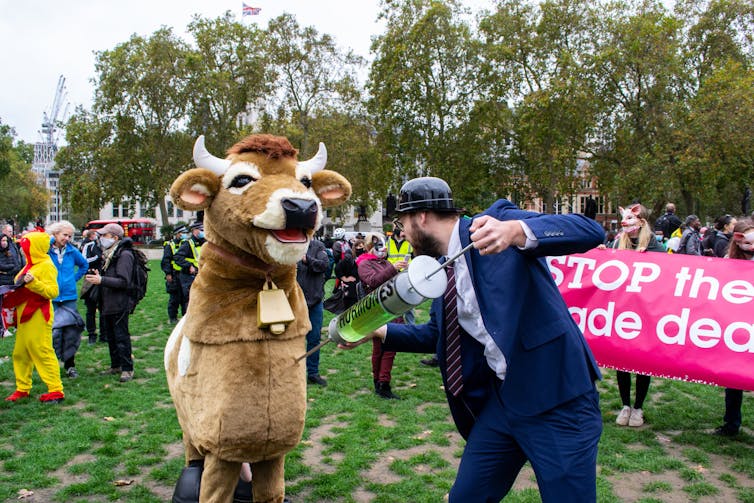Hopes of a ‘Brexit benefit’ from tariffs were short-lived. Here’s what Trump’s pause means for the UK
- Written by Maha Rafi Atal, Adam Smith Senior Lecturer in Political Economy, School of Social and Political Sciences, University of Glasgow

The US has decided – again – to upend the global trading system[1]. With the latest raft of tariffs just beginning to kick in, and after a week in which markets worldwide fell precipitously, the Trump administration announced[2] that it would be suspending high tariffs on nearly 60 countries for 90 days.
The announcement is only a partial reprieve. High tariffs on Mexico, Canada and China, as well as on global imports of steel, aluminium and automotives, remain, as does a 10% baseline tariff on all imports. US tariffs remain the highest[3] they have been since the Great Depression, at levels unprecedented since the modern trade system was created after the second world war.
Before the pause, the UK was already in line for the 10% rate – which some commentators described as a Brexit benefit[4] when compared to the EU’s prospective 20%.
While markets soared[5] on the news of the pause, the damage is was already done. The subsequent rally is recouping some, but not all, losses incurred due to the tariffs already.
Businesses that had prepared[6] for tariffs[7] by bulk-buying imported components ahead of time will have made cuts elsewhere to pay for it. They will not easily be able to reverse course.
The implications for the UK of the latest developments are mixed. All the tariffs imposed on direct UK exports to the US (chiefly[8] steel, automotives and aircrafts, pharmaceuticals and medical equipment) remain in place.
While the US represents the second-largest market for UK goods, the majority of UK exports[9] are in services (like banking and insurance), which the tariffs do not target. If tariffs were to hit direct UK-US goods trade only, the UK would likely be able to weather the shock.
Unfortunately, that’s not how trade works in the 21st century. Instead, two-thirds of trade[10] takes place in what are known as “global value chains”. These are complex networks through which companies move the component parts of products between their own facilities around the world and those of their subcontractors.
Many UK businesses supply components that are incorporated by companies overseas into finished goods ultimately destined for the US. When the US imposes tariffs on those goods, UK manufacturers suffer too – even if direct UK exports to the US remain unchanged.
Global value chains will also reorient in response to trade barriers, as already took place in Asia[11] during Trump’s first term. If businesses reroute their supply chains to avoid the tariff markets, the UK (which is not imposing retaliatory tariffs) could become[12] a “sacrifice zone”[13] (a place where cheaply made, poor-quality or environmentally harmful items are dumped or disposed of, “sacrificing” the wellbeing of local people) for excess supply, undercutting domestic producers.
Yet choosing not to retaliate is key to the UK’s diplomatic strategy. It hopes to stay close to the US in the hope of preferential treatment.
So far, that strategy is yet to bear fruit. The UK hopes to avoid the tariffs through a US trade deal, an objective that the countries have pursued since the UK left the European Union.
The US has repeatedly sought access[15] to the UK agrifood market, a demand that has always been refused due to political opposition to importing American beef and chicken[16].
Brexit adds to this complexity, as the Windsor framework[17] requires food products sold in Northern Ireland to conform to European Union standards. The more standards in the rest of the UK diverge from those of the EU (as they would have to do to secure a US trade deal), the more onerous the checks in the Irish Sea would become.
Keir Starmer’s government has also sought to renegotiate parts of the agreement with the EU, seeking tighter economic ties that will require closer regulatory alignment[18]. Pursuing deregulation to meet US trade demands, however, makes that unlikely.
The tariffs compound this dilemma. If the higher rates return after 90 days, Northern Irish exports to the US will face a lower rate than those from the Republic of Ireland. But US imports to Northern Ireland will be hit with EU tariffs[19] while imports to the rest of the UK will remain tariff-free.
That will create some opportunities. Businesses might choose to operate in Northern Ireland to access a lower tariff rate on their US exports while also producing goods for the EU market.
But it also creates risks. With three different tariff regimes in Britain, Northern Ireland and the Republic of Ireland, goods flowing across both the Irish Sea and the Irish land border could require additional checks. This would risk the very thing the Windsor Framework[20] was meant to avoid.
Given these risks, a 90-day reprieve is a window of opportunity. But with US government policy that can change on a dime (or a post), the UK risks being caught between the rival powers of the US and EU – and trampled in the crossfire.
References
- ^ upend the global trading system (theconversation.com)
- ^ announced (www.nytimes.com)
- ^ the highest (www.usfunds.com)
- ^ Brexit benefit (www.spectator.co.uk)
- ^ markets soared (www.theguardian.com)
- ^ prepared (www.cnbc.com)
- ^ for tariffs (www.bloomberg.com)
- ^ chiefly (oec.world)
- ^ the majority of UK exports (assets.publishing.service.gov.uk)
- ^ two-thirds of trade (repositorio.cepal.org)
- ^ in Asia (ideas.repec.org)
- ^ could become (unitetheunion.org)
- ^ “sacrifice zone” (giace.org)
- ^ JessicaGirvan/Shutterstock (www.shutterstock.com)
- ^ repeatedly sought access (www.bbc.com)
- ^ beef and chicken (www.theguardian.com)
- ^ Windsor framework (www.gov.uk)
- ^ closer regulatory alignment (blogs.lse.ac.uk)
- ^ will be hit with EU tariffs (www.bbc.com)
- ^ Windsor Framework (www.gov.uk)







